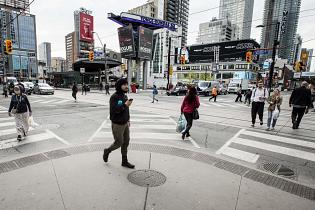Toronto looks to remake downtown Yonge St. with focus on pedestrians
A strip of the busiest pedestrian street in Canada is being considered for a makeover, courtesy of some aging sewer pipes.
The water mains under downtown Yonge St. need to be replaced, meaning the street has to be dug up, and the city wants to seize the opportunity to redevelop a stretch of the iconic roadway with a view to making it more pedestrian-friendly. Mark Garner, executive director of the Downtown Yonge Business Improvement Area, says Yonge has structurally changed little since the subway went in nearly 70 years ago.
“The last time Yonge St. was opened up was in 1948-1952 to put in the subway system. During that time period, in Toronto, we were still harvesting ice off of High Park Pond for refrigeration in Toronto,” said Garner.
According to a new environmental assessment report from the city, some 238,000 people course down the sidewalks of Yonge between Queen and College Sts. over 24 hours on an average summer day.
Car is not king in this congested neighbourhood — up to 75 per cent of people using Yonge here are pedestrians, and over the last 20 years, walking has doubled while driving has decreased by 17 per cent.
But at the same time pedestrians have less than 25 per cent of the space, according to the environmental assessment, one of the first steps in the process of redeveloping the area.
“We who live here are very much concerned about the crowding,” said Margrit Eichler, secretary of the McGill Granby Village Residents’ Association. “It’s very difficult to walk ... you have to sort of shuffle along at the speed of other people because you can’t overtake them. The crowding is really remarkable and it’s going to get worse.”
An additional 8,500 proposed condo units are in development along the strip. Population is expected to double by 2041.
“We would firmly support an option of much more space given to pedestrians,” said Eichler.
In fact, crowding on the sidewalks can prevent people who struggle with mobility from navigating the area at all, says Kristyn Wong-Tam, the local councillor (Ward 13 Toronto Centre).
“The number-one response we’ve heard so far is the sidewalks are far too narrow.”
Public consultations have also pointed in the direction of a better streetscape, with more greenery — currently there are no street trees between Queen and Gerrard St. on Yonge. There are no sidewalk cafés on Yonge within the focus area.
The BIA’s Garner says he is interested in the idea of a flexible space that would draw tourists all year long — saying that Mayor John Tory has mused about getting some kind of winter festival to Toronto. Garner is even open to the idea of occasionally shutting down the area to vehicular traffic for events.
“Yonge St. has always been that convening space for the community,” said Garner, pointing to the street party that broke out there after the Blue Jays won the series in 1992.
“If the Raptors win, guess where everybody is coming? They’re coming to Yonge and Dundas,” Garner said.
At a public meeting in early May, the city introduced six possible alternatives for dividing up the road and sidewalks, which together measure 20 metres across, between pedestrians, cyclists, private vehicles and public transit.
Each of the six alternatives includes its own variants, for a total of 14 different possible new configurations. The options include a car-free Yonge with bike lanes, a Yonge with one bus lane and two bike lanes and a Yonge with two car lanes, one bus lane and one bike lane, among others.
While the cost will depend on which alternative is chosen, preliminary estimates are in the $60 million to $70 million range. The city is hoping to begin construction in 2023 and finish by 2025.
“We have a once-in-a-generation opportunity to reimagine Yonge St.,” said Wong-Tam.
“It has to be beautiful. People are drawn to beautiful streets.”
Wong-Tam said she has been working closely with developers planning towers in the area and they seem interested in ensuring that Yonge retains its status as the city’s iconic street.
“They seem very keen to work with the local communities.”
The second public meeting for input on the environmental assessment is tentatively scheduled for Nov. 21 and a third in the spring of 2020. The environmental assessment component is to be completed in 2020 at which point work on more detailed plans will begin.
Comments
There are 0 comments on this post





